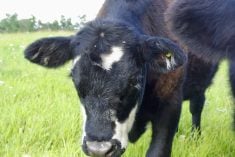Resurgence of an ancient fungus in Prairie grains that causes disease in animals is a reminder of earlier times, a backslide to the Middle Ages and before where it often changed how people lived and ate. Precipitated by cool, wet conditions through early stages of the growing season, ergot (Claviceps purpurea) is expected to be a significant contaminant of grass and cereal crops in 2013. A prolonged flowering period for grasses and cereals this year heightened the ergot risk. Today, ergot is a rare human health issue, but it is not an infrequent visitor to livestock operations.
Read Also

Effect of wildfire smoke on respiratory health in beef cattle
Of all domesticated species, cattle have the smallest relative lung capacity, making them particularly vulnerable to wildfire smoke.
Ergot thrives under cool, damp weather conditions infecting cereal grains at the flowering stage. The fungus produces a number of toxins that reduce the grain’s end-use desirability. Because of its toxicity, tolerances for ergot are tight, for example: .01 per cent (one ergot body per 10,00 wheat kernels, or approximately one litre of grain) in No. 1 Canada Western Red Spring wheat, and .04 per cent in No. 3 Canada Western Red Spring wheat. The Canadian Grain Commission reported in 2011 that upwards of 20 per cent of the wheat crops grown in Western Canada were infected to some degree by ergot. Last year, close to 30 per cent of the hard red spring wheat in Alberta was downgraded due to ergot. Prevalence varies by region and climate.
Ergot affects many wild and cultivated grasses, including many of our small-grain crops. It is most common in rye and triticale. The parasitic fungus (Claviceps) starts damaging crops in the field, replacing one or more kernels in a mature grain head with a hard, dark ergot body. Ergot may be a concern in forage grasses grown for seed production. Grains such as wheat and barley are less likely to become infected, but may still develop levels that result in downgrading. Screenings purchased for feed may contain abnormally high amounts of ergot. Oats are seldom affected. Headland grasses around fields are considered the most likely source of spores and the carryover of ergot from one year to the next. Broadleaf crops like canola are not susceptible to ergot, which makes them an effective crop rotation choice.
The fungal pathogen produces alkaloid toxins that are vasoconstrictors in nature, restricting both blood and milk flow. If ingested, ergot alkaloids can result in convulsions, hallucinations, gangrene, and death. LSD, the hallucinogen, was originally isolated from ergot. The first sign of ergot poisoning in livestock is often lameness caused by a restriction of blood flow to the extremities. Most domestic species are susceptible to ergot poisoning including cattle, pigs, poultry and horses.
The poisonous alkaloids produced by ergot affect animals in several different ways. Pregnant females fed ergot in grain or hay can abort. Abortions have been reported in cattle, horses and pigs. Laying and breeder hens can also be affected by ergot. Tolerance for ergot in pregnant or breeding animal rations is zero.
Toxic levels of ergot in growing and finishing livestock rations affects performance, which may not become apparent for six to eight weeks after contaminated grain is introduced.
In animals, classic signs of ergot poisoning are produced by the effect it has on peripheral circulation. Sustained intake of ergot causes vasoconstriction, or shutting down of blood supply to the extremities. Over time, poor blood supply to peripheral areas causes gangrene and sloughing of the tail, ear tips and hooves. In chronic cases an entire foot or claw will slough. Blood-starved extremities freeze in cold weather, compounding the problem. It is unlikely that animals affected to this extent will ever recover and animal welfare becomes an overriding concern.
There seems to be no clear answer to how much is too much. In the view of some nutritionists, the ergot limit for pigs is zero. For all other species, the maximum limit is one kernel per 1,000 or 0.1 per cent by weight (10 ergot bodies per litre of grain). Cattle will usually tolerate a maximum of 12 g of ergot consumption per day (10 ergot bodies weigh approximately one gram). Some feed mills will not accept grain deliveries with ergot levels above 0.04 to 0.06 per cent (four to six ergot-infected kernels per litre of grain). The risk associated with selling contaminated complete feeds and pelleted rations is high.
For producers swath grazing there is no easy way to assess the degree of ergot infestation. Producers need to evaluate swaths on a case-by-case, field-by-field basis, pulling them apart, calculating how much ergot is present and making a judgment call. If swaths look like they contain borderline toxic levels of ergot, dilute the ergot level by feeding ergot-free forage. Heavily contaminated feed can be diluted with “clean” grain. When in doubt: dilute. It’s better to be on the safe side.
Unfortunately there is no silver bullet for managing ergot poisoning. Disease management, while often difficult, is dependent on reduction of spore transmission to susceptible crops and understanding what risk exists. Things that help include:
- Use of certified seed with low levels of ergot;
- Control of grasses growing along headlands or roadways adjacent to fields;
- Blending feeds;
- Harvest and bin headlands separately;
- Use of gravity tables and colour sorters to clean grain (if economical);
- Crop rotation between cereals and broadleaf crops like canola;
- Ensuring stands are uniform;
- Understanding risk and discussing options with a veterinarian;
- Feed testing (Ergovaline assays — Oregon State University) .
Ergot, a bane of human and animal health dating back to fifth-century Europe when the fungus caused ergot epidemics, remains a potential threat for western Canadian agriculture 1,500 years later. Be especially careful in 2013.
— Dr. Ron Clarke prepares this column on behalf of the Western Canadian Association of Bovine Practitioners. Suggestions for future articles can be sent to Canadian Cattlemen ([email protected]) or WCABP ([email protected]).
















